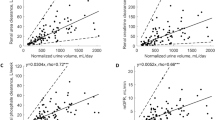Abstract
This study was designed to determine the impact of residual renal function (RRF) on dialysis adequacy indices and clinical outcome parameters in paediatric CAPD patients. Seventeen children on CAPD were included. Residual renal function was described by residual diuresis (UO: urine output), residual renal solute clearances [RR.KT/V (residual renal KT/V), RR.Ccr (residual renal creatinine clearance) and GFR (glomerular filtration rate)]. Pearson's correlation coefficients and multiple linear regression analysis were used in statistical analysis. Mean W.KT/V (weekly KT/V) vas 1.97±0.6 and mean T.Ccr (total Ccr) was 56±32 L/week/1.73 m2. Both of these indices were found to be strongly correlated with RRF (GFR, UO, RR.KT/V and RR.Ccr) (p<0.001), but not with peritoneal solute clearances. W.KT/V was found to be influenced essentially by RR.KT/V (p<0.001) and also dialysate fill volume (DV) (p<0.01). T.Ccr was influenced primarily by RR.Ccr (p<0.001) and serum cr levels (p<0.05). In addition significant positive correlations were detected between serum albumin, haemoglobin (Hb), haematocrit (Htc) levels and residual diuresis (p<0.05) and a significant negative correlation was found between mean blood pressure and residual diuresis (p<0.05). It was concluded that the mean values of W.KT/V and T.Ccr were heavily influenced by RRF. Almost all variations in W.KT/V and T.Ccr represented changes in RRF. In addition, anaemia, hypertension and hypoalbuminaemia, which are known as clinical criteria of inadequate dialysis, were found to be influenced by residual diuresis. Thus one of the goals of paediatric nephrologists must be the preservation of renal reserve. Since the rate of decline in RRF was significantly lower in CAPD, it should be the first choice of long-term maintenance dialytic therapy for children who have residual renal reserve.
Similar content being viewed by others
References
Odel, H. M., Ferns, D. O., Power, H.: Peritoneal lavage as an effective means of extra renal excretion. Am. J. Med., 9, 63 (1950).
Maxwell, M. N., Rockney, R. E., Kleeman, C. R., Twiss, M. R.: Peritoneal dialysis. 1. Technique and application. J. Am. Med. Assoc., 170, 917 (1959).
Tenckhoff, H., Schechter, H.: A bacteriologically safe peritoneal access device for repeated peritoneal dialysis. Trans. Am. Soc. Artif. Intern. Organs., 14, 181 (1968).
Tenckhoff, H., Blagg, C. R., Kurtis, K. F., Hickman, R. D.: Chronic peritoneal dialysis. Proc. Eur. Dial. Transplant. Assoc., 10, 363 (1973).
Kohaut, E. C.: Continuous ambulatory peritoneal dialysis: a preliminary pediatric experience. Am. J. Dis. Child., 135, 270 (1981).
Salusky, I. B., Lucullo, L., Nelson, P., Fine, R. N.: Continuous ambulatory peritoneal dialysis in children. Pediatr. Clin. North. Am., 29, 1005 (1982).
Alexander, S. R., Honda, M.: Continuous peritoneal dialysis for children: a decade of worldwide growth and development. Kidney Int., 43(Suppl. 40), 65 (1993).
Maiorca, R., Cancarini, G.: Outcome of peritoneal dialysis: comparative studies. In: Gokal, R., Nolph, K. D. (eds): Textbook of Peritoneal Dialysis. Kluwer Academic, Dordrecht 1994, p. 699.
Lameire, N., Van Biesen, W.: The impact of residual renal function on the adequacy of peritoneal dialysis. Perit. Dial. Int., 17(Suppl. 3), 102 (1997).
Keshaviah, P. R., Nolph, K. D., Van Stone, J. C.: The peak urea concentration hypothesis: A urea kinetic approach to comparing the adequacy of continuous peritoneal dialysis and hemodialysis. Perit. Dial. Int., 9, 257 (1989).
Twardowski, Z. J., Nolph, K. D.: Peritoneal dialysis: How much is enough? Semin. Dial., 1, 75 (1988).
Churchill, D. N.: Outcome studies in adequacy of dialysis. Perit. Dial. Int., 17(Suppl. 3), 42 (1997).
Keshaviah, P.: Adequacy of CAPD: A quantitative approach. Kidney Int., 42(Suppl. 38), 160 (1992).
Walk, T. L. M., Schröder, C. H., Reddingius, R. E., Lelivelt, M., Monnens, L. A. H., Willems, H. L.: Adequate dialysis? Measurement of KT/V in a pediatric peritoneal dialysis population. Perit. Dial. Int., 17, 175 (1997).
Rottembourg, J.: Residual renal function and recovery of renal function in patients treated by CAPD. Kidney Int., 43(Suppl. 40), 106 (1993).
Ravid, M., Lang, R., Pobson, M.: The importance of daily urine volume and residual renal function in patients treated by chronic hemodialysis. Dial. Transplant., 9, 763 (1980).
Friis-Hansen, B.: Body water compartments in children: changes during growth and related changes in body composition. Pediatrics, 28, 169 (1961).
Du Bois: A formula to estimate the approximate surface area if height and weight be known. Arch. Int. Med., 17, 863 (1916).
Faller, B., Lameire, N.: Evolution of clinical parameters and peritoneal function in a cohort of CAPD patients followed over 7 years. Nephrol. Dial. Transplant., 9, 280 (1994).
Lysaght, M. J., Vonesh, E. F., Gotch, F., Ibels, L., Keen, M., Lindholm, B. et al.: The influence of dialysis treatment modality on the decline of remaining renal function. ASAIO Trans., 37, 598 (1991).
Nolph, K. D.: Is residual renal function better preserved with CAPD than with hemodialysis? [Letter.] Am. Kidney Fund. Nephrol., 7, 1 (1990).
Feber, J., Schärer, K., Schaefer, F., Mikova, M., Janda, J.: Residual renal function in children on haemodialysis and peritoneal dialysis therapy. Pediatr. Nephrol., 8, 579 (1994).
Author information
Authors and Affiliations
Rights and permissions
About this article
Cite this article
Bakkaloğlu, S.A., Yalçinkaya, F., Tümer, N. et al. Impact of Residual Renal Function on Dialysis Adequacy in Paediatric CAPD Patients. Int Urol Nephrol 31, 821–826 (1999). https://doi.org/10.1023/A:1007114101077
Issue Date:
DOI: https://doi.org/10.1023/A:1007114101077




